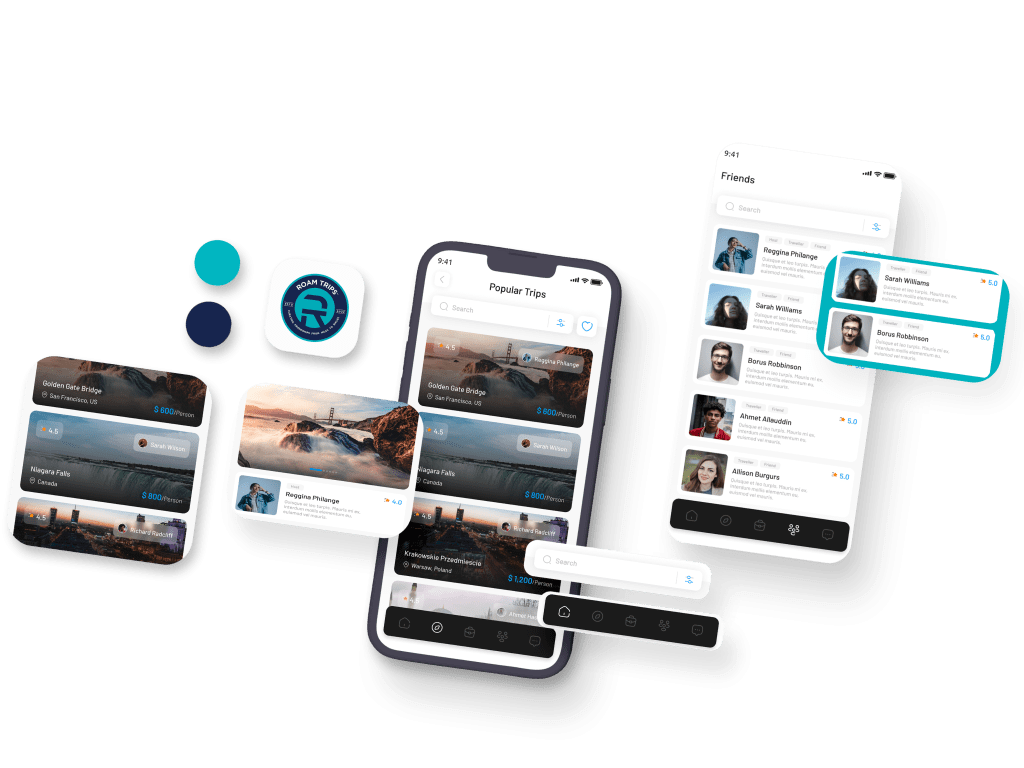Navigating the Strengths and Drawbacks: An In-Depth Look at Hybrid Mobile App Development Frameworks in 2024
Hybrid frameworks have grown in popularity in the ever-changing world of mobile app development, providing a combination of cost-effectiveness and cross-platform compatibility. As we approach 2024, Let’s explore the pros and cons of some of the best hybrid mobile app frameworks that are shaping the market in these competitive times.
Begin by gaining an understanding of hybrid app development and hybrid platforms
The hybrid app development process involves creating an application within a single project and framework capable of targeting various platforms, including Android, iOS, Windows, and more. Hybrid platforms software is appealing because developers can build a single codebase applicable across multiple custom hybrid platforms. Except for certain program features, the most crucial being the UI, which customers desire to adapt to their preferred platform, developers need to write the code only once. This approach allows for code reuse when designing the app for any other target platform, making it the best way to develop hybrid mobile apps.
Two undeniable facts propel the demand for custom hybrid platforms: they are easier to create than native programs, and their source code can extend a company’s reach across various platforms, including the web.
Hybrid mobile app development is especially appealing to businesses because it allows them to enter the mobile market on all major platforms at the same time.
Let’s delve into the pros and cons of leading the best hybrid mobile app frameworks
When it comes to mobile app development, these four hybrid platforms are the primary approaches for creating applications.
- React Native
Pros:
- Performance:
React Native stands out for its exceptional performance, providing near-native speed. This is accomplished through its architecture, which enables components to be compiled into native code. As a result, React Native apps can provide a smooth and responsive user experience on par with completely native apps.
- Large Community:
One of React Native’s major features is its large and active community, making it the best way to develop hybrid mobile apps. With a big user base, developers may take advantage of ongoing support, frequent upgrades, and an abundance of third-party libraries and plugins. This community-driven ecosystem adds to the framework’s robustness and provides developers with access to a diverse set of resources.
- Code Reusability:
React Native encourages code reusability between hybrid platforms. Developers can build a large amount of the software at once and utilize it for both iOS and Android apps. This not only speeds up development but also simplifies maintenance by allowing modifications to be done in a single codebase rather than separate ones for each platform.
Cons:
- Learning Curve:
The learning curve for React Native can be challenging for developers, particularly for those unfamiliar with React.js. While React Native shares similarities with React.js, mastering the best hybrid mobile app framework requires understanding its mobile-specific components, navigation, and other platform-specific nuances. For teams transitioning to React Native, this initial learning curve may impact the speed of the development process.
- Native Modules:
While React Native includes numerous native modules, certain advanced or platform-specific functionality may need the use of native code. This can complicate the development process for hybrid platforms because developers may need to transition between React Native and native languages such as Java or Swift to perform specific functions. It is critical to manage native modules properly to get the needed functionality without sacrificing performance or user experience.
- Flutter
Pros
- Engaging User Interface:
Flutter includes a large number of widgets that allow developers to create visually appealing custom hybrid platforms and consistent user experiences. These widgets are created with versatility in mind, enabling the construction of seamless and engaging app experiences.
- Rapid Reload:
Flutter’s Hot Reload capabilities stand out as one of its most notable features in constructing the best hybrid mobile app framework. This functionality empowers developers to observe real-time changes to the program as they code, fostering a highly iterative and efficient development process. It facilitates fast testing, troubleshooting, and fine-tuning without the need for lengthy application restarts.
- Language of Darts:
Flutter makes use of the Dart programming language, which is intended to be simple and easy to read. Dart is simple to learn and use for developers who are familiar with object-oriented programming. Its syntax is clear, and the language contains current capabilities, making it an excellent choice for developing strong and scalable systems.
Cons
- Size of the Community:
While the Flutter community is rapidly expanding, it may not be as large as those of other well-established frameworks. A tiny community can make it difficult to discover thorough resources, solutions to specific problems, or third-party plugins. However, the community’s growth shows that adoption and support will increase with time.
- App Dimensions:
Flutter apps may have bigger file sizes than applications produced using other frameworks. This is partly because Flutter contains its rendering engine, which adds to the overall size of the app. While this may not be a major worry for many applications, it is something to think about, especially for projects that prioritize app size.
- Xamarin
Pros
- Native Performance:
Xamarin distinguishes itself by delivering near-native performance. This is accomplished by compiling code into native binaries, allowing applications to take advantage of the full power and speed of the underlying hybrid platforms. The performance is equivalent to native language apps written in Swift or Java.
- Integration with Microsoft Technologies:
As a Microsoft product, Xamarin interfaces smoothly with the company’s array of tools and technologies. This is the best way to develop hybrid mobile apps for developers working in Windows-centric settings. Xamarin enables the direct integration of technologies like Visual Studio, Azure, and other Microsoft services, resulting in a single development experience.
- Single Codebase:
Maintaining a single codebase for both iOS and Android hybrid platforms is one of Xamarin’s core features. Developers can develop the application’s fundamental logic in C# and .NET once, and Xamarin will translate and convert it into native instructions for each target hybrid platform. This simplifies the development process and makes maintenance easier.
Cons
- Size of the Community:
While Xamarin has a dedicated and growing community, it is not as large as some of its competitors, such as React Native or Flutter. A tiny community may need more resources, third-party libraries, and community-driven solutions. However, it is crucial to note that Microsoft actively supports the Xamarin community.
- Learning Curve:
Xamarin requires developers to be familiar with C# and the .NET framework. The learning curve may be minimal for developers who are already familiar with these technologies. However, for those coming from various programming backgrounds, particularly web developers used to JavaScript, the move to C# and the.NET ecosystem may be difficult.
- Ionic
Pros
- Wide compatibility
Ionic is built on web technologies such as HTML, CSS, and JavaScript, and it interfaces smoothly with major web frameworks such as Angular. Because of this broad compatibility, developers may harness their existing web development abilities, making the shift to mobile app development easier. The framework’s integration with Angular provides an organized and quick method for developing cross-platform applications.
- Rapid prototyping
Ionic facilitates rapid prototyping and iterative development for custom hybrid platforms. Its simple and declarative syntax, coupled with a collection of pre-built UI components, allows developers to swiftly mock-up and test various functionalities. This capability proves particularly advantageous in the initial stages of app development, emphasizing the fine-tuning of ideas and features before committing to a full-scale implementation.
- Cost-Effective
One of Ionic’s distinguishing aspects is its open-source nature. Ionic is accessible for free as an open-source framework, which drastically decreases development costs. This makes it an excellent solution for low-cost enterprises or businesses wishing to develop cross-platform apps without a large financial investment. Furthermore, the widespread availability of community-driven plugins and extensions contributes to cost-effectiveness.
Cons
- Performance
While Ionic is well-suited for designing less resource-intensive apps, it may struggle with complicated applications or graphic-intensive tasks. Because Ionic renders using web technologies and a web view container, it may not meet the performance levels of completely native applications. This constraint may be an issue for projects where optimal performance is required.
- Limited Native Access:
Ionic applications may encounter constraints when directly accessing certain native device functionalities. To get around this, developers may need to use additional plugins or use native code. While Ionic provides a variety of plugins for accessing native functionality, there may be times when developers face hurdles or dependence on platform-specific features that necessitate custom native development. This can complicate the development process, especially if the feature is not widely supported by existing plugins.
Here are the best practices you should keep in mind for developing the best hybrid mobile app framework
- Prioritize User Experience:
Make user experience a top priority in your app development approach for hybrid platforms. A great user experience is critical to the success and acceptance of your application.
- Framework Selection:
Choose the best hybrid mobile app framework that fits your project requirements perfectly. Each option, such as React Native, Flutter, Xamarin, or Ionic, has various advantages; measure them against your requirements for maximum development efficiency.
- Comprehensive App Testing:
Thoroughly test your application on a variety of devices. This extensive testing approach guarantees that your software runs smoothly, remains responsive, and provides a great user experience across all hybrid platforms.
- Strategic App Promotion:
Create a well-planned promotion strategy to increase the exposure and appeal of your app. To effectively reach and engage your target audience, use social media, app stores, and focused marketing campaigns. To stand out in the competitive mobile app landscape and ensure the success of your application, thoughtful promotion is essential.
Conclusion
In conclusion, the realm of hybrid mobile app development in 2024 offers a diverse landscape of the best hybrid mobile app frameworks, each presenting unique factors to weigh.. React Native, Flutter, Xamarin, and Ionic continue to shape the industry, providing developers with versatile tools to navigate the demands of cross-platform compatibility. As organizations weigh the pros and cons of these frameworks, it becomes evident that the choice should align with project-specific needs. Whether prioritizing performance, a visually appealing UI, seamless integration, or cost-effectiveness, the success of an application hinges on careful framework selection, comprehensive testing, and strategic promotion. By keeping user experience at the forefront and staying abreast of best practices, developers can navigate the complexities of app development with hybrid platforms and deliver impactful solutions in the dynamic landscape of mobile technology.


